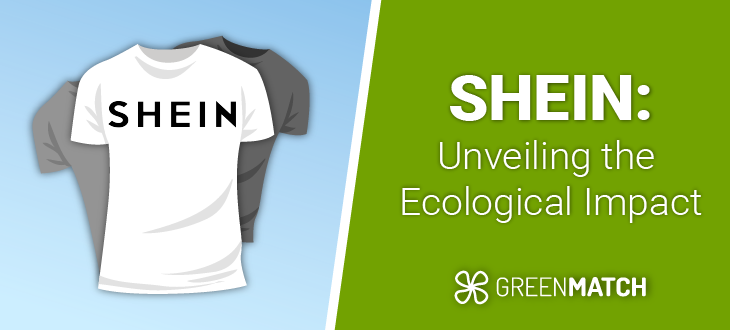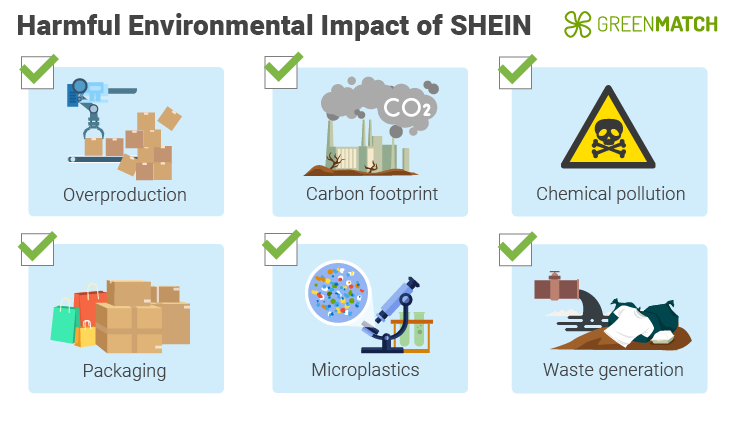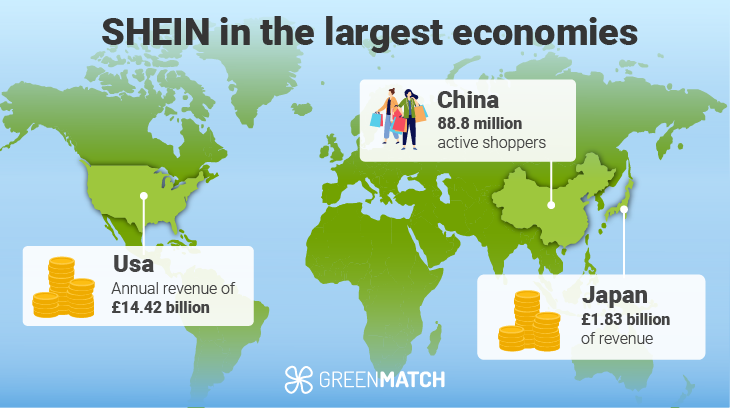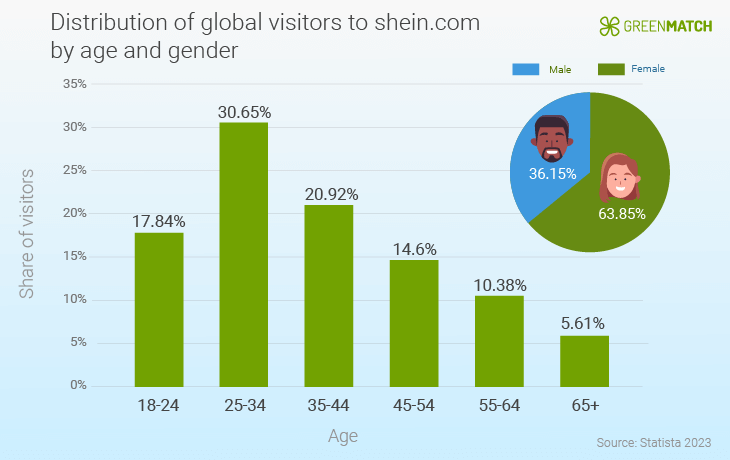- GreenMatch
- Blog
- Is SHEIN Bad for the Environment? Statistics, Trends, Facts and Quotes
Is SHEIN Bad for the Environment? Statistics, Trends, Facts and Quotes

When entering SHEIN's website, one might feel like Black Friday never ends there. Yet any conscious consumer would put the brand's environmental impact and the sustainability of its supply chains first. Its seemingly endless selection and attractive deals raise concerns among environmentalists: is SHEIN bad for the environment?
The answer is undeniably yes. Despite its astonishing revenue of £24 billion in 2022, SHEIN is responsible for 6.3 million tons of CO2 emissions yearly!
This article delves into the environmental impact of SHEIN's fast-fashion practices, exploring the issues of overproduction, resource consumption, and waste generation.
We'll also examine the steps if any, that SHEIN is taking to address these concerns and offer alternative solutions for a more sustainable fashion future.
- What do we mean by SHEIN exactly?
- Is SHEIN sustainable?
- Environmental impact of SHEIN
- Is SHEIN toxic?
- Can you recycle SHEIN materials?
- Is SHEIN material biodegradable?
- Environmental impact compared to everyday things
- What are SHEIN alternatives?
- Statistics, facts and figures about SHEIN
- SHEIN in the largest economies
- FAQ
What do we mean by SHEIN exactly?
SHEIN is a Chinese-Singaporean online clothing retailer known for its clothing at very low prices. It started in 2008 as a wedding dress e-commerce company and eventually evolved into a womenswear retailer.
By the end of 2023, SHEIN's mobile app celebrated 250 million downloads. In Q1 of 2022, its website boasted a whopping 500 million visitors. This made SHEIN the fifth-highest-earning online store, with a revenue of £19.69 billion worldwide.
However, its commercial success is followed by environmental concerns about the company's unethical labour conditions and doubtful sustainability. Let's see what's there to that.
Is SHEIN sustainable?
SHEIN has received criticism regarding its sustainability, which has been marked by sky-rocketing carbon emissions, water contamination, and waste generation. The company has taken steps to address these concerns, such as reducing carbon emissions within its supply chain and exploring more sustainable practices.
Nevertheless, doubts circulate about the efficacy of these measures and the overall sustainability of its business model, which fosters a disposable fashion culture.
Additionally, SHEIN has faced accusations of labour violations, encompassing substandard working conditions and child labour. Despite these challenges, SHEIN has a substantial customer base and has succeeded in the fast-fashion market.
Environmental impact of SHEIN

SHEIN is an undeniable fast-fashion leader, offering trendy styles at rock-bottom prices. It distinguishes itself as a player in the fast fashion industry, constantly updating its website with over 500 products daily. And sell a staggering 36 million pounds of goods worldwide each year. This significant output positions Shein as a leading contributor to textile and environmental pollution within the industry.
But is SHEIN's business model bad for the environment?
The answer is unequivocally yes. SHEIN's environmental impact is significant, encompassing several key areas:
- Overproduction: This ultra-fast fashion giant releases clothes alarmingly highly, producing 35,000 to 100,000 items daily.
- Carbon footprint: SHEIN is responsible for 6.3 million tons of CO2 emissions yearly.
- Water Consumption: The brand consumes an astonishing 7 billion cubic meters of water annually in its production processes.
- Chemical pollution: SHEIN's products contain lead, perfluoroalkyl (PFA), and phthalates. These chemicals can cause liver and kidney damage, hormone imbalances, respiratory problems, anaemia, and allergic reactions.
- Packaging: The company has faced criticism for using non-recyclable materials and excessive packaging, contributing to land waste.
- Microplastics: SHEIN uses synthetic fabrics like polyester and nylon. Accordingly, their decomposition time is 30–40 and 20—200 years. Eventually, microfibres from polyester and nylon clothing end up in laundry effluent, wastewater and seawater.
Is SHEIN toxic?

Before we answer the question directly, let's define what we imply by "toxic." We'll discuss potentially harmful chemicals in SHEIN products and how they impact human health and the environment.
So, for a clearer picture of the toxicity of SHEIN products, let's consider the following arguments:
- Independent tests: Greenpeace and CBC Marketplace found higher-than-allowed levels of chemicals like lead, phthalates, and PFAS in some SHEIN products, exceeding safety regulations in certain regions like the EU.
- Potential health risks: These chemicals may be linked to various health concerns, including hormonal disruption, skin irritation, and developmental issues, especially in children. However, the degree of risk depends on several factors, such as the specific chemicals and their amounts, and individual factors like skin sensitivity and how often the clothing is worn.
Therefore, it's more accurate to say that some SHEIN products contain potentially harmful chemicals, raising concerns about potential health risks, especially with frequent wear.
As a consumer, staying informed is crucial. If you buy from SHEIN, be mindful of these potential risks and consider alternative, more sustainable fashion options whenever possible.
Can you recycle SHEIN materials?

No, if we talk about the material composition of SHEIN clothing. Here's a breakdown:
- Natural fibres: Items made from natural materials like cotton or linen might be recyclable in specific regions if they meet local program guidelines—however, blends containing synthetic materials often become unrecyclable.
- Synthetic fibres: Polyester, nylon, and other synthetic fabrics commonly used by SHEIN can't be recycled through curbside programs due to challenges in sorting and processing.
To be fair, we should acknowledge that SHEIN does make specific recycling efforts through waste management programs.
In 2022, SHEIN stated that the company plans to engage most of its customers within its Extended Producer Responsibility Fund to address global textile waste.
We are thrilled to announce our #EPR fund, establishing a multi-year commitment to advance fashion sustainability efforts. Our first grant will support @theOrisPresent, promoting textile waste management in communities it impacts most. Read more: https://t.co/AiC02V20tC pic.twitter.com/e8w68FyBp9
— SHEIN News (@SHEIN_News) June 7, 2022
The fund supports waste management efforts, with £3.9 million allocated to the OR for its Mabigu Apprenticeship Program in Ghana.
The program focuses on transforming textile waste into new products and improving working conditions for women in the Kantamanto Market.
The OR Foundation plans to redistribute a portion of the allied organisations in Ghana.
Furthermore, facing the backlash regarding the presence of polyester in an alarming amount of its clothing, SHEIN also aims to transition at least 31% of polyester-based products to recycled polyester by 2030.
Together with that, the retailer has launched the exchange program SHEIN Exchange. This is a peer-to-peer resale platform to encourage customers to buy and sell previously owned SHEIN products, promoting mindful consumption and extending the lifecycles of products.
However, as of 2024, the program operates only in the US despite the company's statements to expand to Germany, France, and Spain in 2023.
Is SHEIN material biodegradable?
No, almost all SHEIN clothing isn't biodegradable. This is natural because they use synthetic fabrics like polyester, nylon, and acrylic. These materials, made from fossil fuels, have a complex structure that resists breakdown by microorganisms.
Most SHEIN clothes are made from non-biodegradable synthetics, lasting in the environment for hundreds to thousands of years, contributing to landfill waste and microplastic pollution.
However, some SHEIN clothing might be made from natural fibres like cotton or linen, which could biodegrade under specific conditions. However, any blend with even a small amount of synthetic fibres becomes non-biodegradable.
In short, while there might be a few exceptions, practically all SHEIN clothing is not biodegradable. This poses a significant environmental concern due to its long-lasting impact.
Environmental impact compared to everyday things
SHEIN's annual carbon dioxide emissions are equivalent to approximately 6.3 million tonnes. How bad are SHEINs compared to everyday items or activities? Let’s make a comparison to other items we use every day:
- An average car in the UK emits about 4.10 tonnes of CO2 annually.
- Buses emits 1.4 million of CO2 annually.
- An annual train trip is equivalent to 21.6 million tonnes of CO2. Average household electricity in the UK emits 2.7 tonnes annually.
- A one-way flight from London to New York for one person is 1.0 tonnes CO2.
- If you drank one cup of coffee a day using coffee pods, you'd be contributing to 8.3 kilograms of CO2 in a year.
This way, the brand's business model, which encourages overconsumption, contributes significantly to waste generation.
What are SHEIN alternatives?

When seeking an alternative to SHEIN that meets your needs and aligns with your situation:
- Your values and priorities: How important are sustainability, ethics, and price for you?
- Your style: What kind of clothing do you prefer?
- Your budget: How much can you afford to spend on clothing?
However, you don't necessarily need to purchase new clothes. Consider second-hand clothing stores and platforms which offer pre-owned clothing. ThredUp and Poshmark are good platforms for buying and selling secondhand clothing.
Also, you could opt for clothing rental services, which allow you to rent clothing for a specific time, reducing the need to buy new items you might only wear once. Platforms like Rent the Runway and Nuuly may be a good option.
Also, you could try brands that position themselves as ethical and sustainable throughout their production processes.
| Brand | Positioning |
|---|---|
| Patagonia | Prioritises using recycled materials, reducing waste, and minimising footprint. |
| Everlane | Values ethical factories and transparency in pricing and manufacturing. |
| Hernest Project | Using natural materials like TENCEL and organic cotton. |
| Kotn | Using organic cotton and ensuring ethical labour practices in its supply chain. |
| Thousand Fell | Using PETA-approved recycled uppers that offer sustainable footwear alternatives. |
Yet, it is worth noting that despite your desire for more ethical alternatives, certain products, like fast-fashion items, will only exist unsustainable unless there is a significant shift in consumer behaviour.
In other words, while there's demand for cheap fast-fashion products, affordable yet unsustainable options will prevail.
So, what's the real alternative? Consumers holding back their money and demanding change can be a powerful force that can drive the fashion industry toward more sustainable practices.
Statistics, facts and figures about SHEIN
Here's more data to give you a clearer picture of SHEIN
- SHEIN's target audience is women aged 25-34.
- Spain, Italy, and Saudi Arabia are the top 3 countries in the EMEA area by the number of SHEIN downloads, with Spain being the leader with 6.38 million downloads.
- In 2022, SHEIN was in the top 5 e-commerce stores with a revenue of £24 billion.
- In 2022, SHEIN scored 0–10% on the Fashion Transparency Index due to 83% of SHEIN's suppliers violating worker health and safety conditions.
- Independent investigations claim that SHEIN's workers are paid 4 cents per item, £510 monthly.
- SHEIN was valued at £919 million in 2022.
SHEIN in the largest economies

SHEIN has a significant presence in the largest economies around the world. Let's take a look at some key statistics. The company has experienced significant growth in recent years, particularly in the United States and Brazil, which have become the largest markets.
This growth is further fuelled by their target audience, mainly women, Gen Z, men, and people with low to middle income, focusing on offering affordable fashion items.
Women dominated Shein's visitor base in December 2023, making up roughly 64% of global traffic. Men accounted for the remaining 36%.
When it comes to age, young adults seem to be driving the trends on Shein. In December 2023, a whopping 30% of the website's global visitors belonged to the 25-34 year old age group. Following closely were those aged 35-44, accounting for nearly 21% of the site's traffic.

SHEIN has continued to expand its reach globally, serving consumers in France, Russia, Germany, and over 150 other countries.
The USA
In 2021, Shein experienced a significant surge in its annual revenue in the United States, reaching £14.42 billion, a considerable leap from the previous year's £1.44 billion. Despite already being the third most downloaded shopping app globally in 2021, with a staggering 200 million downloads, Shein continued to make remarkable strides in the US market.
Notably, the United States emerged as Shein's largest market by revenue, surpassing even its home country, China. The US market, accounting for a substantial portion of Shein's overall usage, secured its position as the company's second-largest market, trailing only behind Brazil.
The growth trajectory persisted into 2022, with Shein achieving a remarkable annual revenue of £20.8 billion in the United States, marking an impressive 44% increase from the previous year.
In 2021, it ranked as the third most downloaded shopping app, trailing only Shopee and Meesho.
In 2023, Shein's influence in the United States continued to expand, with an estimated 88.8 million active shoppers, of which 17.3 million were based in the US.
China
China is Shein's paramount market by total usage, closely trailed by Brazil, Mexico, and the US. As of 2024, Shein holds an extensive user base in China, with an estimated 88.8 million active shoppers.
The brand's financial success in China is evident in its annual revenue growth. In 2021, Shein's revenue in China surged impressively from £1.44 billion to £5.5 billion. This upward trajectory continued into 2022, with Shein experiencing a remarkable 44% increase in annual revenue, reaching £20.8 billion.
Japan
In 2023, Shein garnered a 1.4% awareness level in Japan, indicating a growing presence in the market. This awareness translated into substantial financial success, with Shein's annual revenue in Japan reaching £1.83 billion in 2021.
FAQ
No, SHEIN isn’t considered a sustainable brand amid its recycling and exchange endeavours. Most of its products are made of unrecyclable and non-biodegradable materials and were proven to contain dangerous chemicals.
SHEIN’s low prices are achieved through mass production, outsourcing manufacturing to low-cost regions, and potentially questionable labour practices.
No, SHEIN is hardly recyclable, as most of its products are made of synthetic materials which can’t be recycled.
SHEIN produces between 30,000 and 100,000 items daily, using virgin polyester and consuming large amounts of oil, contributing to high CO2 emissions. This rapid production model is considered unsustainable.
SHEIN’s operations result in 6.3 million tons of carbon dioxide emissions annually. This is significantly higher than the U.N. recommended target for fashion companies to help limit global warming.
We strive to connect our customers with the right product and supplier. Would you like to be part of GreenMatch?

- What do we mean by SHEIN exactly?
- Is SHEIN sustainable?
- Environmental impact of SHEIN
- Is SHEIN toxic?
- Can you recycle SHEIN materials?
- Is SHEIN material biodegradable?
- Environmental impact compared to everyday things
- What are SHEIN alternatives?
- Statistics, facts and figures about SHEIN
- SHEIN in the largest economies
- FAQ

